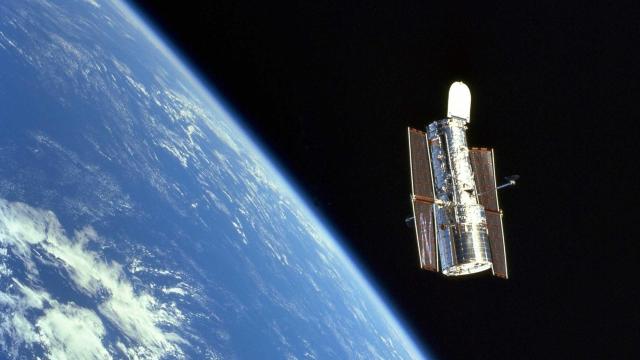Like any satellite in Earth orbit, the Hubble Space Telescope is sinking, and it’s been doing so for the past 33 years. A proposed solution from two space startups offers an intriguing strategy for safely boosting Hubble’s orbit, allowing NASA to extend the lifespan of its storied observatory.
Hubble is currently healthy, but atmospheric drag will eventually cause it to re-enter our planet’s atmosphere at some point during the mid-to-late 2030s. Since launching in 1990, the telescope’s orbital height has fallen by roughly 30 kilometres.
Not ready to say goodbye, NASA issued a Request for Information (RFI) late last year, asking the commercial sector to devise strategies for reboosting Hubble’s orbit. The winning team would then have to provide the necessary resources and services to get the job done, including the launch vehicle, spacecraft, crew (if applicable), and mission operations (excluding Hubble operations).
SpaceX expressed interest shortly after the RFI was posted, saying it’s working on a feasibility study. The Elon Musk-led company is looking to leverage its Polaris Program, a series of missions organised and led by billionaire astronaut Jared Isaacman. Exact details of the SpaceX plan are not known, but the involvement of the Polaris Program and Isaacman suggest it would be a crewed mission aboard the company’s Crew Dragon spacecraft.
We now know of a second response to NASA’s request (assuming SpaceX goes through with its proposal): a joint proposal pitched by California-based Momentus Space and Tokyo-based Astroscale. Working together, the two companies would relocate Hubble to a higher Earth orbit and then remove any threatening debris within the telescope’s new orbit.
The collaboration makes sense, as Momentus’s Vigoride platform is designed to transport payloads across various orbits. Just yesterday, Momentus announced that Vigoride-5’s experimental water-propulsion system lifted the ‘space tug’ some 3 kilometres above its original orbit. In response to a Gizmodo query, a Momentus spokesperson confirmed that the company’s Microwave Electrothermal Thruster (MET), which uses distilled water as propellant, would be used in the mission to boost Hubble’s orbit, should this bid be chosen.
“Even at 33, Hubble is fully capable of continuing its mission; where it is ageing is in its orbital stability,” John Rood, Momentus chief executive officer, said in a company statement. “I am thrilled that we collaborated to offer NASA a very cost-effective way to continue to operate this billion-dollar scientific investment by leveraging new robotic in-space servicing technology.”
As for Astroscale, a startup seeking to provide orbital trash removal services, its contribution would be in providing rendezvous, proximity operations, and docking services — a suite of capabilities otherwise known as RPOD.
The proposed mission to lift Hubble’s orbital trajectory would be completely robotic, precluding the need for humans to be launched to space. The proposed plan would see a yet-to-be-named small rocket launching a Vigoride space tug to low Earth orbit. The spacecraft, equipped with Astroscale’s RPOD tech, would approach and capture the space-based telescope. Locked together, Vigoride would perform a series of manoeuvres in the attempt to raise Hubble by as much as 50 km — a higher orbit than the one originally occupied by the telescope. This task complete, the system would then undock from Hubble and begin the process of removing potentially threatening debris in Hubble’s orbital vicinity.
Much of this is experimental and untested, and that could make NASA a bit nervous when considering this proposal. That said, Ron Lopez, president and managing director of Astroscale U.S., said the plan gives NASA options, “options that were not available during the five previous crewed servicing missions and that leverage the best of in-space servicing to achieve mission objectives and advance U.S. leadership in space.”

Those five previous crewed servicing missions referred to by Lopez are the Space Shuttle missions performed between 1993 and 2009, during which the crews replaced batteries, gyroscopes, and electronics boxes, and installed updated science instrumentation. Hubble was designed for in-space servicing, which could prove useful during the attempt to raise its orbit. We’ll have to wait for NASA to choose a plan and a team, but it’s a relief to know that the space agency is looking out for one of its most prized possessions.
